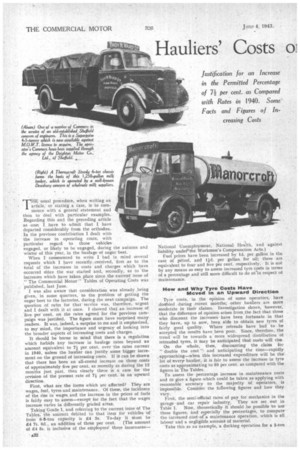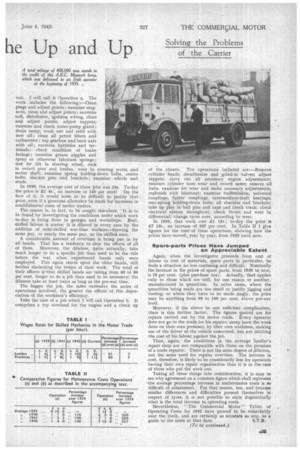Hauliers' Costs a he Up and Up
Page 24

Page 25

If you've noticed an error in this article please click here to report it so we can fix it.
THE .usual procedure, when writing an article, or stating a case, is to commence with a general statement and then to deal with particular examples. Regarding this and the preceding article as .one-, I have to admit that I have departed considerably from the orthodox. In the previous contribution I dealt with the increase in operating costs, with particular regard to those vehicles engaged, or likely to be engaged, during the autumn and winter of this year, in the haulage of sugar beet.
When I commenced to write I had in mind several requests which I have recently received, first as to the total of the increases in costs and charges which have occurred since the war started and, secondly, as to the increases which have taken place since the current issue of ." The Commercial Motor" Tables of Operating Costs was published, last June.
I was also aware that consideration was already being given, in some quarters, to the problem of getting the sugar beet to the factories, during the next campaign. The question of rates for that seraAce was, therefore, urgent and I dealt with it at once. I showed that an increase of five per cent. on the rates agreed for the previous campaign was justified. The figure must have surprised many readers. It was, indeed, a surprise to me and it emphasized, to Iny mind, the importance and urgency of looking into the broader aspects of increasing costs and charges.
It should be borne in mind that there is a regulation which forbids any increase in haulage rates beyond an amount equivalent to 71 per cent, over the rates current in 1940, unless the haulier can justify some bigger increment on the ground of increasing costs. If it can be shown that there has been an all-round increase on those costs of approximately five per cent, as recently as during the 12 months just past, then clearly there is a case for the revision of the present rate of 71 per cent. in an upward direction.
First, what are the items which are affected? They are wages, fuel, tyres and maintenance. Of these, the incidence of the rise in wages and the increase in the prices of fuels is fairly easy to assess—except for the fact that the wages increase varies in differently graded areas.
Taking Grade I, and referring to the current issue of The Tables, the amount debited to that item for vehicles of. from 6-8-ton capacity is £4 5s. To-day it must be
£4 7s. 6d., an addition of three per cent. (The amount of £4 5s. is inclusive of the employees' three insurances—
National Unemployment, National Health, and against liability undeilthe Workmen's Compensation Acts.) Fuel prices have been increased by Id. per gallon in the case of petrol, and 1/d. per gallon for oil; these are equivalent to four and five per cent. respectively. It is not by any means so easy to assess increased tyre costs in terms of a percentage and still more difficult to do so in respect of maintenance.
How and Why Tyre Costs Have Mcved in an Upward Direction Tyre costs, in the opinion of some operators, have dottbled during recent months; other hauliers are more moderate in their claims. Investigation shows, however, that the difference of opinion arises from.the fact that those who discount the increases have been fortunate in that they have, up to now, been able to obtain new tyres of fairly good quality. Where retreads have had to be accepted the results have been poor. Since, therefore, the trend will be towards a more widespread distribution of retreaded tyres, it may be anticipated that costs will rise.
On the whole, then, discounting the claim to: " double the cost "and anticipating the time—rapidly approaching—when this increased expenditure will be the lot of every haulier. it is fair to assess the increase in tyre costs as approximating to 50 per cent, as compared with the figures in The Tables.
To assess the percentage increase in .maintenance costs and to give a figure which could be taken as applying with reasonable accuracy to the majority of operators, is impossible. Consider the following figures and how they vary.
First, the semi-official rates of pay for mechanics in the garage • and car repair industry.. They are set out in Table L Now, theoretically it should be possible •to use these figures, and especially the percentages, to compute the increased cost•ola maintenance operation, which is all labour and a negligible amount of material.
Take this as an example, a docking operation for a 3-ton
van. I will call it Operation a. The work includes the following :—Clean plugs and adjust points; examine magneto, clean and adjust points; examine coil, distributor, ignition wiring, clean and adjust points; adjust tappets; examine and check water-pump gland ; drain sump, wash out and refill with new oil ; clean all petrol filters and carburetter; top gearbox and back axle with oil ; examine batteries and terminals; check condition of brake facings ; examine grease nipples and spray or otherwise lubricate springs; test for lift in steering wheel, rock in swivel pins and bushes, wear in steering worm and sector shaft; examine spring holding-down bolts, centre bolts, shackle pins and brackets; examine wheels and studs.
In 1939, the average cost of those jobs was 10s. To-day the price is £1 4s., an increase of 140 per cent! On the face of it, it would seem to be difficult to justify that price, even if a generous allowance be made for increases in establishment costs of motor traders.
The reason is, in fact, to be sought elsewhere. It is to be found by investigating the conditions under which work to-day is being done in garages and workshops. Real, skilled labour is scarce; it is diluted in every case by the addition of semi-skilled war-time workers—drawing the same pay, or nearly the same pay, as the skilled man.
A considerable amount of overtime is being put in by all hands. That has a tendency to slow the efforts of all of them. Moreover, the dilutees, quite naturally, take much longer to do a specific job than used to be the rule before the war, when experienced hands only were employed. This again reacts upon the older hands, still further slackening the tempo of their work. The total of their efforts is that skilled hands are taking from 60 to 80 per cent, longer to do a job than used to be necessary; the dilutees take at least twice as long as the pre-war time.
The bigger the job, the more extensive the series of operations involved, the greater the effects of this depreciation of the workmen's efficiency.
Take the case of a job which I will call Operation b. It comprises a top overhaul for the engine and a check up
of the chassis. The operations included are:—Remove cylinder heads; decarbonize and grind-in valves; adjust tappets; carry out all necessary engine adjustments; measure cylinder bore wear and record same; remove all hubs, examine for wear and make necessary adjustments, replenish with lubricant; examine transmission, universal couplings, Spicer couplings, intermediate-shaft bearings, rear-spring holding-down bolts, all shackles and brackets; take up play in ball pins and caps and check track; check electrical system throughout; check thrust and wear in differential; change tyres over, according to wear.
In 1939, that work cost £1 15s.; to-day the price. is £7 13s., an increase of 337 per cent. In Table II I give figures for the cost. of these operations, showing how the prices have moved, year by year, from 1939 until now.
Spare-parts Prices Have Jumped an Appreciable Extent Again, when the investigator proceeds from cost of labour to cost of materials, spare parts in particular, he finds a situation no less confusing and difficult. Nominally the increase in the prices of spare parts, from 1939 to now, is 15 per cent. (plus purchase tax). Actually, that applies only to those which are -still, for one reason or another, manufactured in quantities. In other cases, where the quantities being made are too small to justify jigging and 'tooling, or where they have to be made singly, the price may be anything from 60 to 100 per cent, above pre-war level.
Moreover, if the above be not sufficient complication, there is this further factor. The figures quoted are for repairs carried out by the motor trade. Every operator does not go to the trade for his repairs; many have the work done on their own premises, by their own workmen, making use of the driver of the vehicle coacerned, but not debiting the cost of his labour against the job. Then, again, the conditions in the average haulier's repair shop are not comparable with those on the premises of a trade repairer. There is not the same degree of dilution, not the same need for regular overtime. The increase in cost, therefore, is likely to be considerably less for operators having their own repair organization than it is in the case of those who put the work out.
Taking all these things into consideration, it is easy to see why agreement on a common figure which shall represent the average percentage increase in maintenance costs is so difficult of attainment. For that reason, too, and because similar differences and difficulties present themselves in respect of tyres, it is not possible to state dogmatically what is the total increase in operating costs.
Nevertheless, " The Commercial Motor" Tablet of Operating Costs for 1942 have proved to be remarkably near the truth, and are certainly as accurate as any, as a
guide to the costs at that date. S.T.R. . (To be continued.)




















































